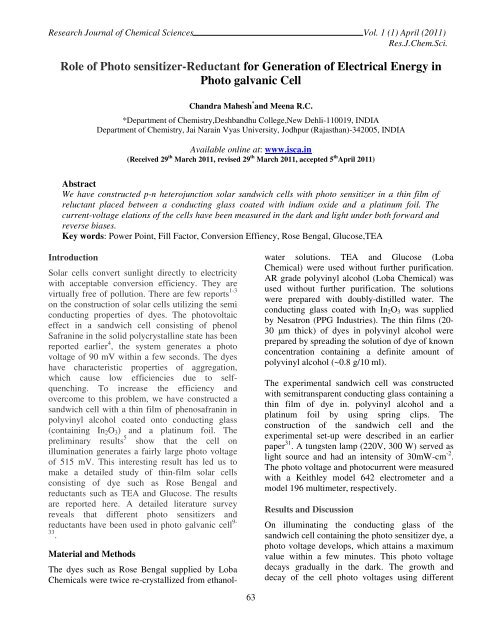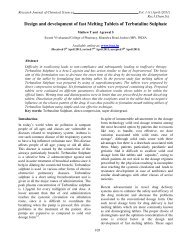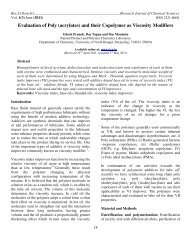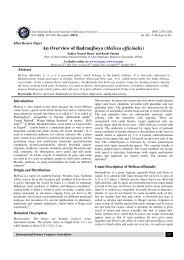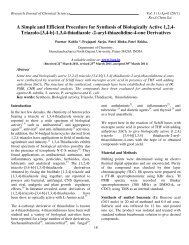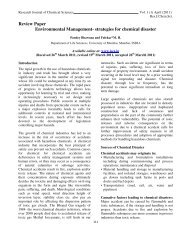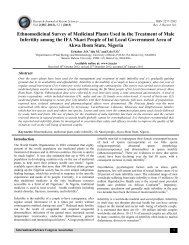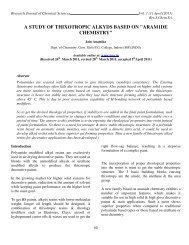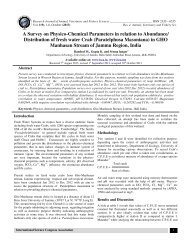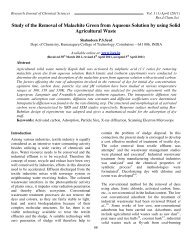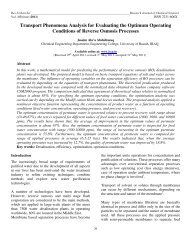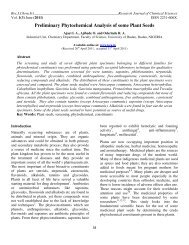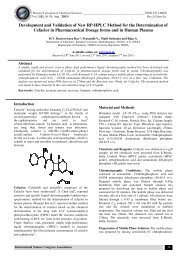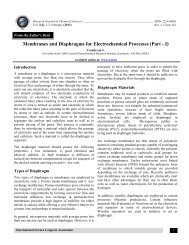Role of Photo sensitizer-Reductant for Generation of ... - ISCA
Role of Photo sensitizer-Reductant for Generation of ... - ISCA
Role of Photo sensitizer-Reductant for Generation of ... - ISCA
You also want an ePaper? Increase the reach of your titles
YUMPU automatically turns print PDFs into web optimized ePapers that Google loves.
Research Journal <strong>of</strong> Chemical Sciences Vol. 1 (1) April (2011)<br />
Res.J.Chem.Sci.<br />
<strong>Role</strong> <strong>of</strong> <strong>Photo</strong> <strong>sensitizer</strong>-<strong>Reductant</strong> <strong>for</strong> <strong>Generation</strong> <strong>of</strong> Electrical Energy in<br />
<strong>Photo</strong> galvanic Cell<br />
Chandra Mahesh * and Meena R.C.<br />
*Department <strong>of</strong> Chemistry,Deshbandhu College,New Dehli-110019, INDIA<br />
Department <strong>of</strong> Chemistry, Jai Narain Vyas University, Jodhpur (Rajasthan)-342005, INDIA<br />
Available online at: www.isca.in<br />
(Received 29 th March 2011, revised 29 th March 2011, accepted 5 th April 2011)<br />
Abstract<br />
We have constructed p-n heterojunction solar sandwich cells with photo <strong>sensitizer</strong> in a thin film <strong>of</strong><br />
reluctant placed between a conducting glass coated with indium oxide and a platinum foil. The<br />
current-voltage elations <strong>of</strong> the cells have been measured in the dark and light under both <strong>for</strong>ward and<br />
reverse biases.<br />
Key words: Power Point, Fill Factor, Conversion Effiency, Rose Bengal, Glucose,TEA<br />
Introduction<br />
Solar cells convert sunlight directly to electricity<br />
with acceptable conversion efficiency. They are<br />
virtually free <strong>of</strong> pollution. There are few reports 1-3<br />
on the construction <strong>of</strong> solar cells utilizing the semi<br />
conducting properties <strong>of</strong> dyes. The photovoltaic<br />
effect in a sandwich cell consisting <strong>of</strong> phenol<br />
Safranine in the solid polycrystalline state has been<br />
reported earlier 4 , the system generates a photo<br />
voltage <strong>of</strong> 90 mV within a few seconds. The dyes<br />
have characteristic properties <strong>of</strong> aggregation,<br />
which cause low efficiencies due to selfquenching.<br />
To increase the efficiency and<br />
overcome to this problem, we have constructed a<br />
sandwich cell with a thin film <strong>of</strong> phenosafranin in<br />
polyvinyl alcohol coated onto conducting glass<br />
(containing In 2 O 3 ) and a platinum foil. The<br />
preliminary results 5 show that the cell on<br />
illumination generates a fairly large photo voltage<br />
<strong>of</strong> 515 mV. This interesting result has led us to<br />
make a detailed study <strong>of</strong> thin-film solar cells<br />
consisting <strong>of</strong> dye such as Rose Bengal and<br />
reductants such as TEA and Glucose. The results<br />
are reported here. A detailed literature survey<br />
reveals that different photo <strong>sensitizer</strong>s and<br />
reductants have been used in photo galvanic cell 9-<br />
33 .<br />
Material and Methods<br />
63<br />
The dyes such as Rose Bengal supplied by Loba<br />
Chemicals were twice re-crystallized from ethanolwater<br />
solutions. TEA and Glucose (Loba<br />
Chemical) were used without further purification.<br />
AR grade polyvinyl alcohol (Loba Chemical) was<br />
used without further purification. The solutions<br />
were prepared with doubly-distilled water. The<br />
conducting glass coated with In 2 O 3 was supplied<br />
by Nesatron (PPG Industries). The thin films (20-<br />
30 µm thick) <strong>of</strong> dyes in polyvinyl alcohol were<br />
prepared by spreading the solution <strong>of</strong> dye <strong>of</strong> known<br />
concentration containing a definite amount <strong>of</strong><br />
polyvinyl alcohol (~0.8 g/10 ml).<br />
The experimental sandwich cell was constructed<br />
with semitransparent conducting glass containing a<br />
thin film <strong>of</strong> dye in. polyvinyl alcohol and a<br />
platinum foil by using spring clips. The<br />
construction <strong>of</strong> the sandwich cell and the<br />
experimental set-up were described in an earlier<br />
paper 31 . A tungsten lamp (220V, 300 W) served as<br />
light source and had an intensity <strong>of</strong> 30mW-cm -2 .<br />
The photo voltage and photocurrent were measured<br />
with a Keithley model 642 electrometer and a<br />
model 196 multimeter, respectively.<br />
Results and Discussion<br />
On illuminating the conducting glass <strong>of</strong> the<br />
sandwich cell containing the photo <strong>sensitizer</strong> dye, a<br />
photo voltage develops, which attains a maximum<br />
value within a few minutes. This photo voltage<br />
decays gradually in the dark. The growth and<br />
decay <strong>of</strong> the cell photo voltages using different
Research Journal <strong>of</strong> Chemical Sciences Vol. 1 (1) April (2011)<br />
Res.J.Chem.Sci.<br />
dyes <strong>of</strong> different concentrations in the thin film are<br />
shown in Fig.1. The open-circuit photo voltage<br />
(V oc ) increases with increase inµ concentration (C)<br />
<strong>of</strong> dye till it reaches a maximum <strong>for</strong> effective<br />
conversion <strong>of</strong> light in electrical energy and follows<br />
a relation that is similar to the Freundlich<br />
adsorption isotherm, i.e. V oc = KC 1/m , where K is a<br />
constant and m is a number greater than one.<br />
Power Conversion Effiency <strong>of</strong> <strong>Photo</strong> galvanic<br />
Cell: One <strong>of</strong> the important characteristics <strong>of</strong> any<br />
electrochemical cell is its power conversion<br />
effiency. The i-V characteristics <strong>of</strong> Rose Bengal–<br />
TEA and Rose Bengal-Glucose. <strong>Photo</strong> galvanic<br />
cells have been investigated to estimate the power<br />
conversion efficiency <strong>of</strong> the cell. The possible<br />
power output from the cell can be obtained from<br />
the rectangle <strong>of</strong> maximum area which can be<br />
drawn under i-V curve. The power point (appoint<br />
on the curve where the product <strong>of</strong> potential and<br />
current was maximum) in i-V curves were<br />
determined and their fill factors were also<br />
calculated. These data are summarized in table 2.<br />
The efficiency <strong>of</strong> the Rose Bengal-TEA photo<br />
galvanic cell has been calculated to be 1.248<br />
percent, comparable to that <strong>of</strong> and Rose Bengal –<br />
Glucose photo galvanic cell has been calculated to<br />
be 0.744 percent. Power point (A point where the<br />
product <strong>of</strong> photocurrent and photo potential is<br />
maximum is determined by using i-V curve. Where<br />
the fill factor and Conversion effiency <strong>of</strong> the cell is<br />
calculated by using following <strong>for</strong>mula.<br />
Fill-factor (n) =<br />
Where<br />
Vpp x ipp<br />
Voc x isc<br />
Vpp = photo potential at power point.<br />
ipp = Current at power point.<br />
Voc = potential in open circuit.<br />
isc = Current in short circuit.<br />
Vpp x ipp<br />
Conversion efficiency = x 100%<br />
10.4 Mw /<br />
Per<strong>for</strong>mance <strong>of</strong> the photogalvanic cell: All the<br />
two systems were studied by applying the desired<br />
external load to have the potential and current<br />
64<br />
corresponding to power point. The time t1\2 was<br />
determined after removing the source <strong>of</strong> light. It is<br />
the time taken in reaching half the value <strong>of</strong> power.<br />
The per<strong>for</strong>mance <strong>of</strong> cells was studied and<br />
comparative values are summarized in table 4.<br />
On the basis <strong>of</strong> the observed data, the Rose Bengal<br />
TEA is most efficient from power point <strong>of</strong> view<br />
(Electrochemical Studies <strong>of</strong> <strong>Photo</strong><strong>sensitizer</strong>s)The<br />
value <strong>of</strong> K is 3.16 V, The current-voltage relation<br />
<strong>of</strong> the p-n heterojunction cell in the dark is I = I 0 [1-<br />
(V/V bi )] [exp(eV/kT)-1], where V bi is the total<br />
electrostatic potential <strong>for</strong> the two semiconductors 6<br />
and k is Boltzmann's constant.<br />
When the junction is <strong>for</strong>ward biased, i.e. V >><br />
(kT/e), then I = I 0 [1-(V/V bi )] [exp(eV/kT)-1], when<br />
it is biased in reverse, i.e. V
Research Journal <strong>of</strong> Chemical Sciences Vol. 1 (1) April (2011)<br />
Res.J.Chem.Sci.<br />
extrapolated conductivity at infinite temperature.<br />
The band gaps <strong>of</strong> dyes in a thin film <strong>of</strong> reductant<br />
have been determined directly from conductivity<br />
measurements and plotting lnσ as a function <strong>of</strong><br />
1/T. The results <strong>for</strong> Rose Bengal- TEA and Rose<br />
Bengal-Glucose are 1302.0, and 1080.0 mV,<br />
respectively. There is an interesting correlation<br />
between the activation energies <strong>of</strong> the dyes and the<br />
photo voltages generated in the film containing<br />
dyes. The lower the band gap <strong>of</strong> the dye, the<br />
greater is the photo voltage generated in the solar<br />
cell containing dye. Lower activation energy<br />
means that less energy is required to generate<br />
charge carriers in the semiconductors.<br />
The use <strong>of</strong> dyes in the film increases the efficiency<br />
<strong>of</strong> photo voltage generation by decreasing selfquenching<br />
caused by aggregation. This type <strong>of</strong><br />
solar cell using a polymer <strong>of</strong> low resistivity is<br />
important since its preparation is simple and the<br />
cost is low compared to that <strong>of</strong> other solar cells.<br />
Mechanism: On the basis <strong>of</strong> these observations, a<br />
mechanism is suggested <strong>for</strong> the generation <strong>of</strong><br />
photocurrent in the photo galvanic cell as:<br />
Illuminated Chamber<br />
Dye Dye * (6.1)<br />
Dye * + R Dye (semi or leuco) + R + (6.2)<br />
Platinum Electrode<br />
Dye Dye + e (6.3)<br />
Dark Chamber<br />
Dye + e Dye (semi or leuco) (6.4)<br />
Dye + R + Dye + R (6.5)<br />
Where Dye, Dye*, Dye , R and R+ are the<br />
excited <strong>for</strong>m <strong>of</strong> dye, semi or leuco dye, reductant<br />
and oxidized <strong>for</strong>m <strong>of</strong> the reductant, respectively.<br />
Conclusion<br />
<strong>Photo</strong> galvanic cells are low cost due to the use <strong>of</strong><br />
a dye, which are cheap and used in minute<br />
quantities reductant like Ascorbic acid, is also not<br />
that very expensive. So overall working with a<br />
65<br />
photo galvanic cell has lot <strong>of</strong> scope <strong>for</strong> its<br />
development.<br />
On the basis <strong>of</strong> observation in the whole study it is<br />
concluded that photo galvanic cells are better<br />
option <strong>for</strong> solar energy conversion and storage.<br />
Also this system with better electrical output good<br />
per<strong>for</strong>mance and storage capacity may be used in<br />
near future. According to observed photo galvanic<br />
effect in all these two systems, Rose Bengal-TEA<br />
system was the most efficient in all the ways.<br />
Acknowledgements<br />
The Authors is grateful to Principal, Desh Bandhu<br />
College, kalkaji New Delhi <strong>for</strong> providing the<br />
necessary laboratory facilities<br />
References<br />
1. Meier H., Albrecht W. and Tschirwitz U.,<br />
Angew., Chem. Int. Edn., 11, 1051 (1972)<br />
2. Chamberlain G.A., Mol. Cryst. Liq. Cryst., 93,<br />
369 (1983)<br />
3. Panayotatos P., Bird G., Sauers R., Piechowski<br />
A. and Husain, S., Sol. Cells., 21, 301 (1987)<br />
4. Rohatgi - Mukherjee K.K., Roy M. and<br />
Bhowmik ,B.B., Sol. Energy, 31, 417 (1983)<br />
5. Bhowmik B.B. and Jana A.K., Energy-The<br />
International Journa, 13, 755 (1988)<br />
6. Sze S.M., Physics <strong>of</strong> Semiconductor Devices,<br />
2 nd edn, Wiley Eastern, New Delhi (1983)<br />
7. Schumacher L.C., Maniche-Afara S. and<br />
Dignam M.J., J. Electrochem. Soc., 133, 716<br />
(1986)<br />
8. Meier H., J. Phys. Chem., 69, 719 (1965)<br />
9. Punjabi P. B., Vardia J., Madhwani S. and<br />
Chaudhary S., J. Power Sources, 159, 747–751<br />
(2006)<br />
10. Madhwani S., Ameta R., Vardia J., Punjabi P.<br />
B. and Sharma V. K., Energy Sources., 29, 721 —<br />
729 (2007)
Research Journal <strong>of</strong> Chemical Sciences Vol. 1 (1) April (2011)<br />
Res.J.Chem.Sci.<br />
11. Bohrmann - Linde C. and Tausch M. W., J.<br />
Chem. Educ., 80, 1471–1473 (2003)<br />
12. Monat J. E. and Mc Cusker J. K., J. Amer.<br />
Chem. Soc., 122, 4092 (2000)<br />
13. Schwarzburg K. and Willig F., J. Phys. Chem.<br />
103B, 5743 (1999)<br />
14. Tennakone K. and Kumara GRR.A., J.<br />
<strong>Photo</strong>chem. <strong>Photo</strong>biol., 117A, 137 (1998)<br />
15.Yadav Sushil, Yadav R. D. and Singh Gautam,<br />
Int. J. Chem. Sci., 6(4), 1960 (2008)<br />
16. Meena R.C., Gautam Singh and K.M., Gangotri<br />
K. M., Afinidad 59, 253-256 (2003)<br />
17. Meena, R.C., and R.S. Sindal., Int. J. Chem.<br />
Sci., 2(3), 321-330 (2004).<br />
18.Ameta, Suresh C., Sadhana Khamesra, Anil K.,<br />
Chittoro and K.M. Gangotri.,Int. J. Energy Res.,<br />
13, 643, (1989).<br />
19.Gongotri,K.M., R.C. Meena and Rajni Meena.,<br />
J. <strong>Photo</strong>chem and photobiol. A: Chem; 123, 93,<br />
(1999)<br />
20.Gangotri, K.M. and Chhagan Lal., Int. J. Energy<br />
Res., 24, 365, (2000).<br />
21.Fisher, A.C., L.M. Peter, E.A., Ponomareve,<br />
A.B., Walker, and K.G.U. Wijayantha.,J. Phys.<br />
Chem. B. 104(5), 949-958 (2000)<br />
22.Zhang, Zhi-Ying. and Chun-yanliu., J.<br />
<strong>Photo</strong>chem. and <strong>Photo</strong>bio. A: Chemistry 130, 139<br />
(2000)<br />
23.Gratzel, Michael., J. <strong>Photo</strong>chem.and <strong>Photo</strong>biol.<br />
A: Chemistry 164, 3-14, (2004).<br />
24.Coralie Houarner-Rassin, Errol Blart, Pierrick<br />
Buvat and Fabriceodobel., J. <strong>Photo</strong>chem. and<br />
<strong>Photo</strong>biol A: Chemistry 186, 135, (2007).<br />
25. Bandara J., U.W. Pradeep and R.G.S.J.<br />
Bandara., Solar cells, 170, 273 (2005)<br />
26. Sindal R. S., Gunsaria R. K., Chandra<br />
Mahesh and Meena R. C., The Arabian Journal<br />
<strong>for</strong> science and Engineering, 31(2A), 177 (2006)<br />
27. Minna Toivola, Lauripeltokorpi, Janne Halme,<br />
Peter Lund, Solar energy materials and solar<br />
Cells, 91, 1733 (2007)<br />
28. Kenisarin mural. and Khamid Mahkamov,<br />
Renewable and Sustainable energy reviews, 11,<br />
1913, (2007)<br />
29. Sindal R. S., Chandra Mahesh and Meena R.<br />
C., J. Ind. Council Chem., 25(2), 131-136, (2008).<br />
30. Sirvi Sonal, Meena Vijay Kumar and Meena R<br />
C, J. Indian Chem.Soc. 85, 825 (2008)<br />
31. Meena R. C., J. Indian Chem. Soc., 85, 280<br />
(2008)<br />
32. Sindal R. S., Chandra M., Kumar V. and<br />
Meena R. C., Energy Sources, 31(16), (2009)<br />
33. Kumari Manju, Pachwarya Ram Babu and<br />
Meena R .C, Energy Sources, 31(11), (2009)<br />
66
Research Journal <strong>of</strong> Chemical Sciences Vol. 1 (1) April (2011)<br />
Res.J.Chem.Sci.<br />
1500<br />
1400<br />
PHOTOPOTENTIAL (mV)<br />
1300<br />
1200<br />
1100<br />
1000<br />
900<br />
800<br />
700<br />
600<br />
2<br />
LIGHT ON<br />
LIGHT OFF<br />
500<br />
400<br />
300<br />
200<br />
100<br />
0<br />
100 200 300 400 500 600<br />
TIME (min)<br />
Figure-1: The effect <strong>of</strong> light on photo voltage generation <strong>for</strong> solar cells containing dye-reductants<br />
mixtures in the thin film. The dyes reductant mixtures<br />
Table-1: Electrical parameters<br />
Observations Rose Bengal - TEA System Rose Bengal-Glucose System<br />
Open Circuit voltage (Voc) 1302.0 mV 1080.0 mV<br />
<strong>Photo</strong>potential (V) 1185.0 mV 968.0 mV<br />
Equilibrium <strong>Photo</strong>current (ieq) 175.0 µA 160.0 µA<br />
Maximum <strong>Photo</strong>current (imax) 210.0 µA 190.0 µA<br />
Short circuit current (isc) 175.0 µA 160.0 µA<br />
Current at power point (ipp) 135.0 µA 110.0 µA<br />
Potential at power point (Vpp) 962.0 µA 704.0 µA<br />
Power at power point 68.8 µA/min 62.8 µA/min<br />
Rate <strong>of</strong> <strong>Generation</strong> 62.4 µA/min 56.8 µA/min<br />
Conversion Efficiency 1.248% 0.744%<br />
Charging Time 180.0 min 260.0 min<br />
t1/2 90.0 min 60.0 min<br />
Fill factor (n) 0.56 0.44<br />
67
Research Journal <strong>of</strong> Chemical Sciences Vol. 1 (1) April (2011)<br />
Res.J.Chem.Sci.<br />
Table-2: i-V Characteristics <strong>of</strong> the photo galvanic cells<br />
Systems Voc (mV) isc (µA) Vpp (mV) ipp (µA) n<br />
Rose Bengal - TEA System 1302 175.0 962.0 135.0 0.56<br />
Rose Bengal-Glucose System 1080 160.0 704.0 110.0 0.44<br />
The conversion efficiency and sunlight conversion data <strong>for</strong> these two systems are reported in table 3.<br />
Systems<br />
Table-3: Conversion efficiency and sunlight conversion data<br />
Fill Factor<br />
(n)<br />
Conversion<br />
Efficiency (%)<br />
Sunlight Conversion Data<br />
<strong>Photo</strong> potential<br />
(mV)<br />
Rose Bengal-TEA 0.56 1.24 1302 210<br />
Rose Bengal-Glucose 0.44 0.74 1080 190<br />
<strong>Photo</strong>current<br />
( µ A)<br />
On the basis <strong>of</strong> these observations, the highest conversion efficiency was found in Rose Bengal –TEA system.<br />
Table-4: Per<strong>for</strong>mance <strong>of</strong> the photo galvanic cells in dark<br />
System Power ( µ W ) t1/2 (min)<br />
Rose Bengal-TEA 68.8 90.0<br />
Rose Bengal-Glucose 62.2 60.0<br />
Fig.2. Linear plots <strong>of</strong> the current-voltage characteristics are shown <strong>for</strong> the cells in the dark (a) and with light<br />
(b) when the junctions are both <strong>for</strong>ward and in reversed biased. The curves 1-2 represent Rose Bengal-TEA<br />
and Rose Bengal-Glucose respectively. The low resistivity <strong>of</strong> Rose Bengal-TEA compared to that <strong>of</strong> other<br />
dye-reductant films results in relatively higher currents at various voltages.<br />
68
Research Journal <strong>of</strong> Chemical Sciences Vol. 1 (1) April (2011)<br />
Res.J.Chem.Sci.<br />
Fig.3. Semilog plots <strong>of</strong> current vs voltage <strong>for</strong> cells in the dark (a) and with light (b). The curves 1-2<br />
represent Rose Bengal-TEAand Rose Bengal-Glucose respectively.<br />
69


